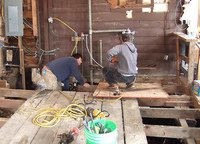WISHA Compliance Extended to Homeowners
/January 2017
by Mike and Janet Showalter
In 1990, the Washington Supreme Court held in Stute v. PBMC1 that a general contractor could be held liable for an injury to a subcontractor's employee that occurred as a result of a WISHA violation committed by that employee. This rule (WRD 27.00) was subsequently extended to include any upper-tier subcontractor who,  like a general contractor, has a non-delegable, specific duty to ensure compliance with all applicable WISHA regulations for “every employee on the jobsite,” not just its own employees.[1] A general or upper-tier contractor is deemed responsible for protecting workers on the jobsite, including “any employee who may be harmed by the employer’s violation of the safety rules.” [2]
like a general contractor, has a non-delegable, specific duty to ensure compliance with all applicable WISHA regulations for “every employee on the jobsite,” not just its own employees.[1] A general or upper-tier contractor is deemed responsible for protecting workers on the jobsite, including “any employee who may be harmed by the employer’s violation of the safety rules.” [2]
Subsequent lawsuits since 1990 have worked vigorously to extend this duty also to owner/developers, landowners whose independent contractors fail to comply with safety and health regulations, and now property owners and other employers, depending on the degree of control exercised and whether they control or create a hazard. Examples of criteria for determining that a property owner falls under these regulations are:
- The essence of the contract with the contractor (whether written or verbal) is the contractor’s personal labor
- The homeowner is in some manner controlling or directing the contractor’s day-to-day activities such as:
- Directing and/or supervising the contractor on how to do the work
- Setting specific work hours, like workday start and end times, or lunch or rest breaks
- Controlling how payment occurs, whether monetary or another form of compensation
- Supplying materials, tools or equipment required to complete work activities.
On October 30, 2016, The Department of Labor and Industries expanded WRD 27.00. The basis for this expansive duty to ensure safety for all employees and non-employees on the jobsite arises from the top entity’s (general contractor, upper-tier contractor, owner, developer, landowner, etc.) “ innate supervisory authority,” which “constitutes sufficient control over the workplace.”[3] The law determines that this entity is in the best position, financially and structurally, to ensure WISHA compliance. Because this entity has authority to direct the working conditions on a construction site, they have ultimate responsibility under WISHA for job safety and health at the job site.
The general contractor (or any entity of similar position and authority) must demonstrate that it is meeting these responsibilities by fulfilling the following:
- must contractually require its subcontractors to provide all safety equipment required to do the job, or furnish the required safety equipment
- develop and implement an Accident Prevention Program
- develop a written site specific Safety Plan that addresses and coordinates the safety issues of all its subcontractors at the site
- require that a site specific Safety Plan is developed in a manner consistent with the relevant WAC regulations
- require its subcontractors to have Accident Prevention Programs and site specific plans consistent with the relevant WAC regulations
- develop a management plan
- make the Accident Prevention Program and all site-specific safety plans available and accessible
- develop a plan that will reasonably discover violations of its Accident Prevention Program or Safety Plan
- must show it has effectively enforced in practice its Accident Prevention Program and/or Safety Plan
- must provide contractual language that requires its subcontractors to comply with all safety rules
- must require its subcontractors to have and enforce a disciplinary schedule that will be followed by its subcontractors
- must include a method of documenting safety violations, as well as a method of recording what, if any, appropriate disciplinary action is taken
The extended reach of this ruling should especially alert homeowners because now they also can be issued citations for violating safety and health requirements if it is determined that they are acting as general contractors. A citation raises the question of liability, which leads to the possibility of a lawsuit where the homeowner will have to defend himself against the claims being made. If found liable, the financial implications can be huge. Be informed before taking on this role!
[1] Stute, 114 Wn.2d at 456, 463-64; accord Kamla, 147 Wn.2d at 122
[2] Afoa v. Port of Seattle, 176 Wn.2d 460, 471, 296 P.3d 800 (2013)
[3] Stute, 114 Wn.2d at 464